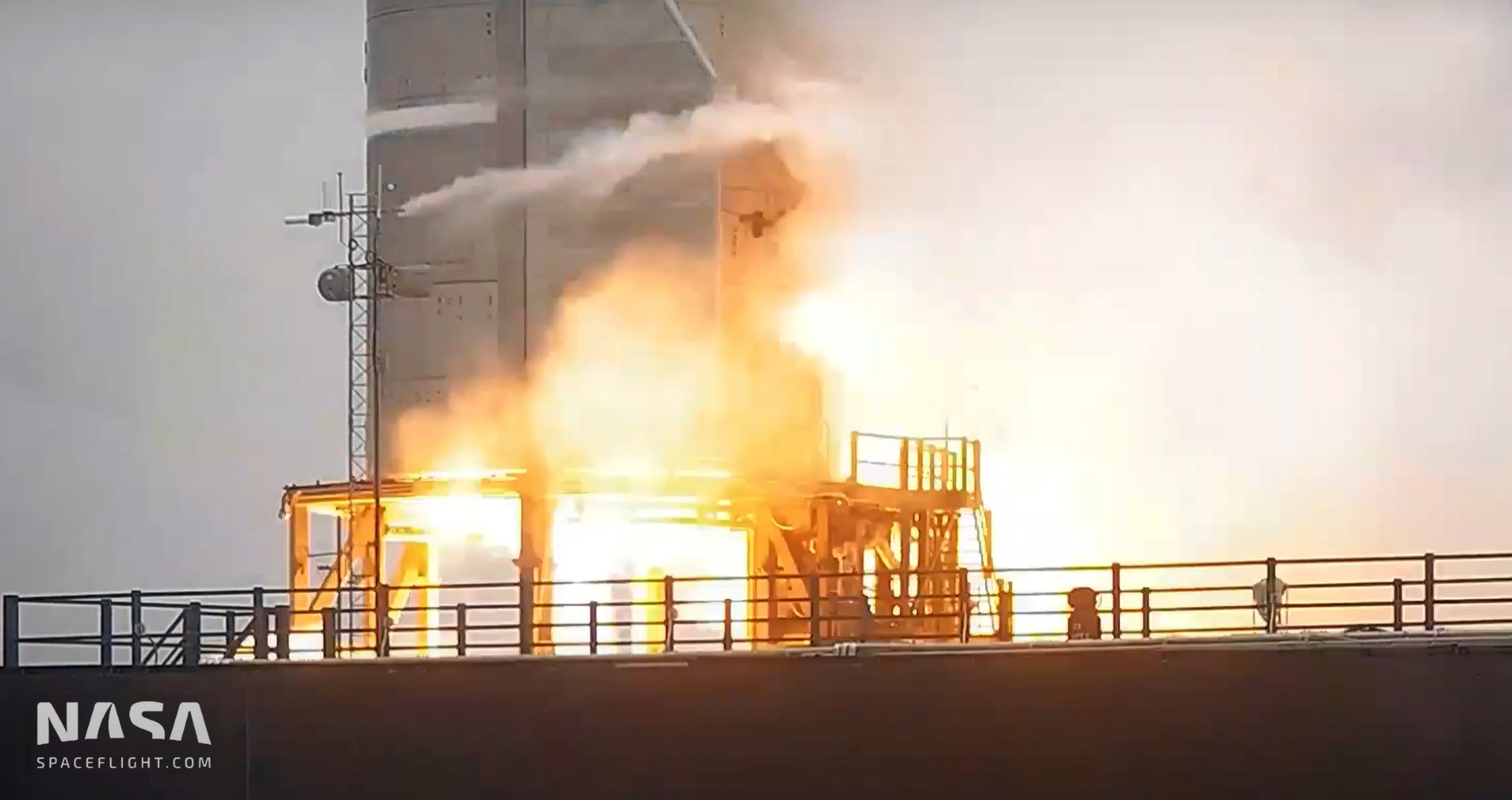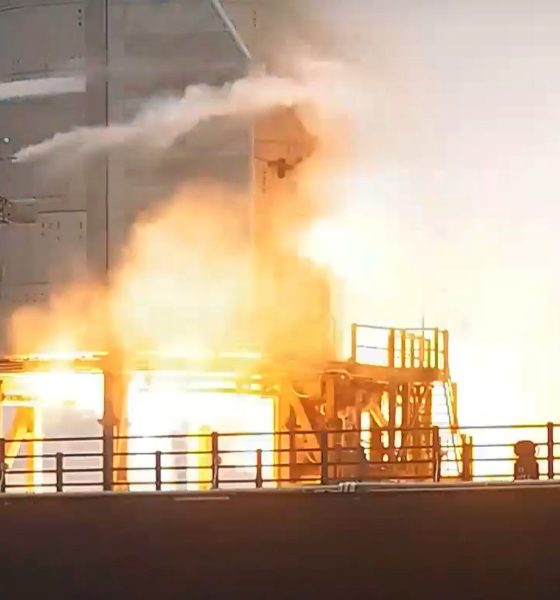

News
SpaceX’s upgraded Starship completes second Raptor engine test in ~24 hours
SpaceX Starship prototype SN15 has completed a second ‘static fire’ test of its Raptor engines in the last 24 hours, hopefully setting up the rocket for a launch and landing attempt on Thursday or Friday.
While Monday’s test was a total success, it’s unclear if April 27th’s static fire went according to plan. Notably, it was much shorter than the Monday engine test and involved either one or two – but not all three – of Starship SN15’s Raptor engines. Historically, unusually brief static fires (~2-3 seconds) aren’t unprecedented, but they’ve generally been part of a process of troubleshooting after a prototype runs into technical issues during earlier testing.
According to Musk, SpaceX also moved to reigniting all three sea level Raptors for landing burns from Starship SN10 onwards, meaning that an intentional two-engine SN15 static fire is either a reversion to earlier two-engine landing burns or a sign of a static fire abort or engine ignition failure. If SpaceX needs to perform another test, particularly if one or more Raptors need to be replaced, Starship SN15’s launch will likely slip into early May. Stay tuned for updates.
SpaceX CEO Elon Musk says that the next Starship launch could happen “later this week” after the company’s first ‘upgraded’ prototype aced a three-engine static fire test on the first try.
While substantially delayed from optimistic initial targets just a week or two after the rocket rolled from factory to launch pad, upgraded Starship prototype serial number 15 (SN15) – outfitted with “hundreds of improvements” – fired up its three Raptor engines for a few seconds around 5pm CDT on Monday, April 26th. Also upgraded, the rocket’s engines seemed to perform nominally and SpaceX ultimately closed out the evening’s testing a few hours early.
Around the same time as SN15’s first static fire attempt was wrapping up, SpaceX distributed safety notices to Boca Chica Village residents, indicating that a second static fire test may be planned on Tuesday. Musk didn’t mention plans for a second static fire, but he did imply that the first test was completed successfully enough to enable Starship SN15 to launch just a few days from now.
Like four other “high-altitude” flight tests before it, Starship SN15 is expected to target a similar ~10-12 kilometer (6-8 mi) apogee and once again attempt to perform a complete ascent, controlled bellyflop, landing flip maneuver, and soft touchdown. Between December 2020 and April 2021, Starships SN8 through SN11 tried and failed to survive that challenge intact, though prototype SN10 did manage to survive for around ten minutes on the ground before its still-hard landing led to an explosion.
All four failures ultimately had different causes. Starship SN8 lost fuel tank pressure, starving its Raptors and causing a near-total loss of thrust seconds before touchdown. One of SN9’s Raptors failed to ignite for a landing burn, triggering an even more aggressive impact with the ground. Starship SN10 landed in one piece but its lone landing engine underperformed when it began to ingest helium ullage gas – a quick-fix implemented after SN8’s pressurization issue. SN11 exploded almost immediately after attempting to ignite its three engines for landing, failing even earlier than its predecessors.
All four flight tests saw each respective Starship prototypes narrowly miss a fully successful and survivable landing, providing SpaceX a great deal of data and direct experience to improve the rocket’s design and operations with. Two of the four failures – SN9 and SN11 – appear to have been the fault of one or more of Starship’s three Raptor engines. Beginning with Starship SN15, SpaceX has moved to an upgraded iteration of the next-generation engine, raising hopes that whatever changes the company has implemented will substantially improve reliability and thus the odds of a successful high-altitude launch and landing test.
As of April 26th and in spite of one or two weeks of delays, the fact that Starship SN15 managed to complete a three-Raptor static fire test on its first true attempt is a great sign that the rocket’s many “improvements” may already be paying dividends. A launch “later this week” would make the effects of those improvements even harder to deny. A successful launch and landing in the next few days would all but guarantee that SpaceX’s process of iterative development is working like a charm. Regardless of whether SN15 survives its first flight, Starship SN16 will likely be ready to take over a matter of days later.

Elon Musk
Elon Musk’s X will start using a Tesla-like software update strategy
The initiative seems designed to accelerate updates to the social media platform, while maintaining maximum transparency.

Elon Musk’s social media platform X will adopt a Tesla-esque approach to software updates for its algorithm.
The initiative seems designed to accelerate updates to the social media platform, while maintaining maximum transparency.
X’s updates to its updates
As per Musk in a post on X, the social media company will be making a new algorithm to determine what organic and advertising posts are recommended to users. These updates would then be repeated every four weeks.
“We will make the new 𝕏 algorithm, including all code used to determine what organic and advertising posts are recommended to users, open source in 7 days. This will be repeated every 4 weeks, with comprehensive developer notes, to help you understand what changed,” Musk wrote in his post.
The initiative somewhat mirrors Tesla’s over-the-air update model, where vehicle software is regularly refined and pushed to users with detailed release notes. This should allow users to better understand the details of X’s every update and foster a healthy feedback loop for the social media platform.
xAI and X
X, formerly Twitter, has been acquired by Elon Musk’s artificial intelligence startup, xAI last year. Since then, xAI has seen a rapid rise in valuation. Following the company’s the company’s upsized $20 billion Series E funding round, estimates now suggest that xAI is worth tens about $230 to $235 billion. That’s several times larger than Tesla when Elon Musk received his controversial 2018 CEO Performance Award.
As per xAI, the Series E funding round attracted a diverse group of investors, including Valor Equity Partners, Stepstone Group, Fidelity Management & Research Company, Qatar Investment Authority, MGX, and Baron Capital Group, among others. Strategic partners NVIDIA and Cisco Investments also continued support for building the world’s largest GPU clusters.
News
Tesla FSD Supervised wins MotorTrend’s Best Driver Assistance Award
The decision marks a notable reversal for the publication from prior years, with judges citing major real-world improvements that pushed Tesla’s latest FSD software ahead of every competing ADAS system.

Tesla’s Full Self-Driving (Supervised) system has been named the best driver-assistance technology on the market, earning top honors at the 2026 MotorTrend Best Tech Awards.
The decision marks a notable reversal for the publication from prior years, with judges citing major real-world improvements that pushed Tesla’s latest FSD software ahead of every competing ADAS system. And it wasn’t even close.
MotorTrend reverses course
MotorTrend awarded Tesla FSD (Supervised) its 2026 Best Tech Driver Assistance title after extensive testing of the latest v14 software. The publication acknowledged that it had previously criticized earlier versions of FSD for erratic behavior and near-miss incidents, ultimately favoring rivals such as GM’s Super Cruise in earlier evaluations.
According to MotorTrend, the newest iteration of FSD resolved many of those shortcomings. Testers said v14 showed far smoother behavior in complex urban scenarios, including unprotected left turns, traffic circles, emergency vehicles, and dense city streets. While the system still requires constant driver supervision, judges concluded that no other advanced driver-assistance system currently matches its breadth of capability.
Unlike rival systems that rely on combinations of cameras, radar, lidar, and mapped highways, Tesla’s FSD operates using a camera-only approach and is capable of driving on city streets, rural roads, and freeways. MotorTrend stated that pure utility, the ability to handle nearly all road types, ultimately separated FSD from competitors like Ford BlueCruise, GM Super Cruise, and BMW’s Highway Assistant.
High cost and high capability
MotorTrend also addressed FSD’s pricing, which remains significantly higher than rival systems. Tesla currently charges $8,000 for a one-time purchase or $99 per month for a subscription, compared with far lower upfront and subscription costs from other automakers. The publication noted that the premium is justified given FSD’s unmatched scope and continuous software evolution.
Safety remained a central focus of the evaluation. While testers reported collision-free operation over thousands of miles, they noted ongoing concerns around FSD’s configurable driving modes, including options that allow aggressive driving and speeds beyond posted limits. MotorTrend emphasized that, like all Level 2 systems, FSD still depends on a fully attentive human driver at all times.
Despite those caveats, the publication concluded that Tesla’s rapid software progress fundamentally reshaped the competitive landscape. For drivers seeking the most capable hands-on driver-assistance system available today, MotorTrend concluded Tesla FSD (Supervised) now stands alone at the top.
News
Elon Musk’s Grokipedia surges to 5.6M articles, almost 79% of English Wikipedia
The explosive growth marks a major milestone for the AI-powered online encyclopedia, which was launched by Elon Musk’s xAI just months ago.

Elon Musk’s Grokipedia has grown to an impressive 5,615,201 articles as of today, closing in on 79% of the English Wikipedia’s current total of 7,119,376 articles.
The explosive growth marks a major milestone for the AI-powered online encyclopedia, which was launched by Elon Musk’s xAI just months ago. Needless to say, it would only be a matter of time before Grokipedia exceeds English Wikipedia in sheer volume.
Grokipedia’s rapid growth
xAI’s vision for Grokipedia emphasizes neutrality, while Grok’s reasoning capabilities allow for fast drafting and fact-checking. When Elon Musk announced the initiative in late September 2025, he noted that Grokipedia would be an improvement to Wikipedia because it would be designed to avoid bias.
At the time, Musk noted that Grokipedia “is a necessary step towards the xAI goal of understanding the Universe.”
Grokipedia was launched in late October, and while xAI was careful to list it only as Version 0.1 at the time, the online encyclopedia immediately earned praise. Wikipedia co-founder Larry Sanger highlighted the project’s innovative approach, noting how it leverages AI to fill knowledge gaps and enable rapid updates. Netizens also observed how Grokipedia tends to present articles in a more objective manner compared to Wikipedia, which is edited by humans.
Elon Musk’s ambitious plans
With 5,615,201 total articles, Grokipedia has now grown to almost 79% of English Wikipedia’s article base. This is incredibly quick, though Grokipedia remains text-only for now. xAI, for its part, has now updated the online encyclopedia’s iteration to v0.2.
Elon Musk has shared bold ideas for Grokipedia, including sending a record of the entire knowledge base to space as part of xAI’s mission to preserve and expand human understanding. At some point, Musk stated that Grokipedia will be renamed to Encyclopedia Galactica, and it will be sent to the cosmos.
“When Grokipedia is good enough (long way to go), we will change the name to Encyclopedia Galactica. It will be an open source distillation of all knowledge, including audio, images and video. Join xAI to help build the sci-fi version of the Library of Alexandria!” Musk wrote, adding in a later post that “Copies will be etched in stone and sent to the Moon, Mars and beyond. This time, it will not be lost.”








